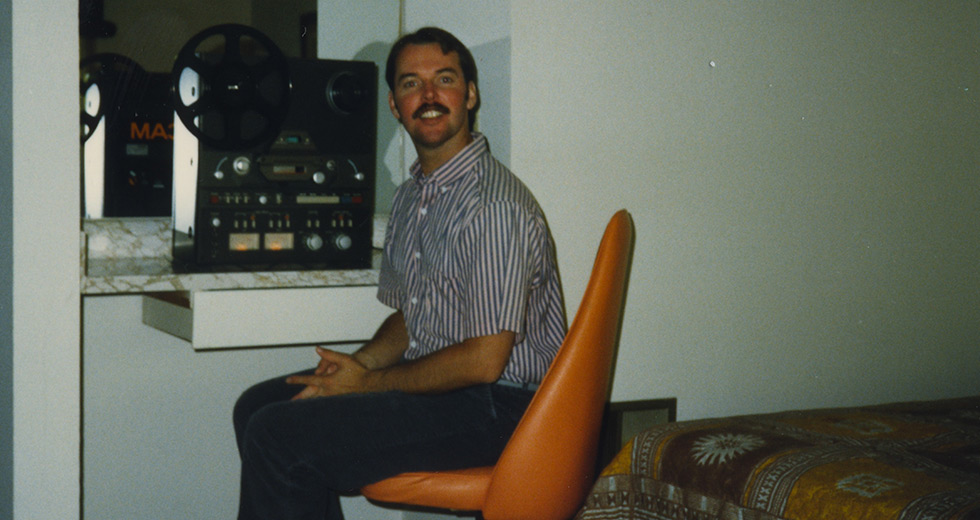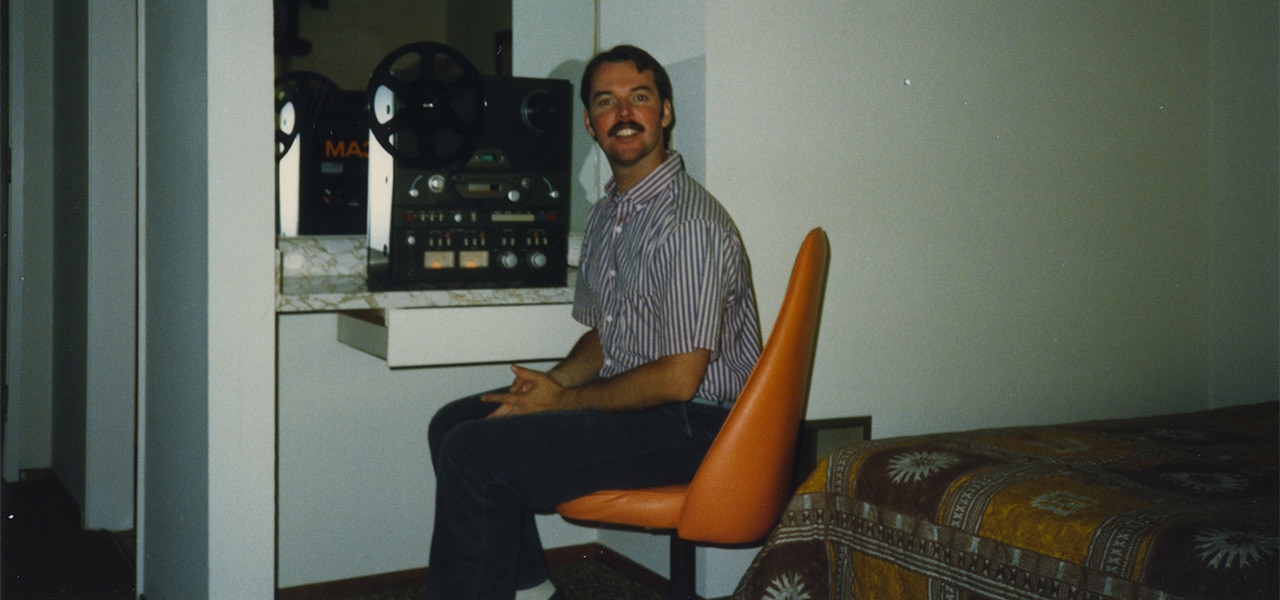
Razormaid!: The Remix Service That Changed the Face of Dance Music
The 1980s were a turbulent period for San Francisco’s dance music community. The euphoria of the disco years were replaced by the uncertainty and loss suddenly brought on by the outbreak of the AIDS epidemic. Yet, through this decade of tragedy came a reshuffling of the city’s club scene that birthed one of its most lasting, yet oddly unsung contributions to the development of electronic dance music.
This is the story of Razormaid!, a quirky remix service whose voluminous edits, sharp artistic direction, and fearless humor helped to guide San Francisco through its darkest hour. Along the way, its releases informed the direction of underground dance music throughout the ‘80s and ‘90s, by turning people on to the darker and weirder electronic undercurrents of Europe. Today, the service’s releases are considered valuable secret weapons by house and techno DJs alike, which is reflected in the absurdly high cost of vinyl copies on the secondhand market.
Subscription remix services boomed in the ‘80s. These were boutique outfits, with names like Disconet, Hot Tracks, Art of Mix, and Mix-It, that had a symbiotic relationship with dance music labels. The labels would provide them with multi-track sessions of songs, and – in turn – the services would employ teams of remixers and DJs to pick over pieces of a track’s radio, dub, and vocal mixes to create novel, dancefloor-centric versions with extended lengths and different EQing. The songs would then be released as compilations, or “issues”, available for purchase to members only; usually working DJs, not the general public.
Razormaid! comes from this world, but it approached the format with a level of style and panache that resembled the multi-sensory approach of Factory Records. It also pushed a different kind of sound. When the service was founded in 1984, the major gay clubs in San Francisco like Trocadero Transfer, I-Beam, and Dreamland, were all dominated by the Baroque hi-NRG vision of Patrick Cowley. Razormaid! instead drifted towards remixes of icy synth-pop, aggressive Belgian EBM, and what might now be termed “minimal wave.”

“‘Where did you come from? Are you like some big hotshot DJ from Miami or Paris?’ They said I was like this enigma. I’d just say, ‘What do you mean? I just came over from my apartment on 17th Street,” says Razormaid! founder and principal editor Joseph Watt, recalling his arrival in the San Francisco nightlife industry, as a DJ at the Trocadero Transfer. Though he’d lived in the city for some time prior, he was a complete unknown. He’d moved there from Southern California, and worked first as a bartender and then later as an auto mechanic. He spent his time performing choral works with a string quartet at his bar, keeping up the formal vocal and theoretical training he received while a student at Chapman University in Orange, California.
Watt’s introduction to the dance music world came through a chance encounter with Art Maharg, a man who would, for a time, become his partner in life as well as in music. They met at a record shop. Maharg was an aspiring DJ and, curious to see what another customer would think of his selections, he pulled Risque’s “The Girls Are Back in Town” and Miro Miroe’s “Nights of Arabia,” and asked Watt his opinion. They quickly clicked and later moved in to an apartment together on 17th Street that looked out on San Francisco’s Castro district.
[Art said,] “This is better than anything I’ve ever heard at Trocadero.” I looked at him and said, “What’s a Trocadero?”
One day, while observing Maharg struggle with the rudiments of turntable control, Watt tried his hand at a mixtape in an effort to help his friend out. “So Art came home and I said, ‘Hey, I want to show you something.’ I went ahead and put a cassette in and just mixed songs together to show him – ‘See because this is E and that’s A and that’s a fourth, that’s why it worked.’” Watt had already moved well beyond beat matching and into the more advanced territory of mixing in key. “It was like looking at a deer in headlights. He kept rewinding the tape and playing it over again saying, ‘You did this? You got those to all line up? This is better than anything I’ve ever heard at Trocadero.’ I looked at him and said, ‘What’s a Trocadero?’” Maharg urged Watt to audition his tape in front of Dick Collier, the club’s owner. Watt was reluctant, “I told him, ‘Me? I’m a car mechanic, you see these fingers? I’m happy.’” Watt eventually acquiesced and gained his first DJ gig as Trocadero Transfer’s Sunday night selector, providing the soundtrack for a party called “Microwave Tea Dance.”
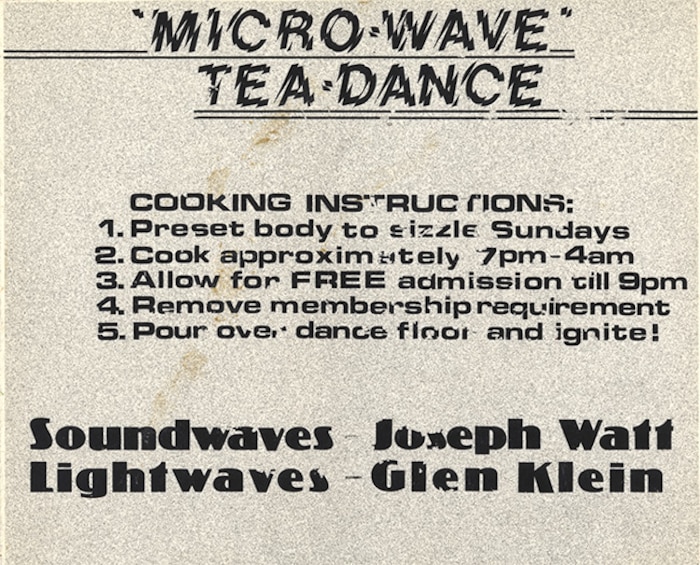
His arrival at Trocadero was met with no small degree of resistance. In the ’70s, the club had been the city’s primary disco venue, a sister space to 12 West in New York, and its programming reflected its past even as late as the mid-’80s. Watt didn’t have much of an interest in nostalgia, and his playlists suggest as much – he served up a novel mixture of synth pop, new wave, and avant-garde rock sounds imported from Europe.
The music was far removed from the upbeat and euphoric disco that constituted the club’s core aesthetic, so to bring people on board, he’d play familiar fare early on and then move out into uncharted territory, “I’d play like Siouxsie and the Banshees into K.C. and the Sunshine Band. I tried to give them a little of everything, but mostly what I wanted. The rules were very simple: I’ll play everything you want, with no hesitation, ‘til nine. From nine to eleven, we’ll negotiate. From eleven on, you will listen to what I want to play and there is no negotiation, the door is locked, and I don’t need any requests, thanks, have a nice night.”
Many of the tracks Watt wanted to use as a DJ, however, were poorly suited for the concerns of a dancefloor. Propaganda’s “Dr. Mabuse,” in particular, vexed him. In the sleeve notes to Razormaid!’s 7th Anniversary CD box set, he writes, “It was all fucked up: bad intro, bad exit, a bunch of stuff in the middle that no one wanted to hear.” So he persuaded Maharg to purchase a basic tape editing block that would allow him to reconfigure the song to his own specifications. In effect, this was the first Razormaid! edit, and though that exact edit was never released, Watt’s later official Razormaid! version is instructive as to the dominantly rhythmic character of his remixing work in general.
Instead of beginning atmospherically, with spoken word and washy pads, he snips out the bass and drums and loops them as an extended intro, building tension for a full two minutes before finally teasing in the vocals. Later, he powers through the drumless break, inserting a relentless percussive drive that keeps punching for the length of the track’s seven minutes. This extreme focus on rhythm was, and still is, a defining characteristic of what makes the Razormaid! sound so distinct.
A friend of mine said, “That’s all you do anymore, you’re such a slave to the blade – you’re a real razor maid!”
Watt was inspired, and he began re-editing prolifically. His first entry into professional remix services came in 1983, with a remix of Rational Youth’s punky and energetic “City of Night” which appeared on Hot Tracks’ Series 2, Issue 5. His choice of song stands out next to the rest of the material on that issue – a black sheep in comparison to Rob Kimbel and Steve Algozino’s remix of Irene Cara’s slap happy hi-NRG anthem “Flashdance... What a Feeling” and Frank Schmidt’s edit of Menage’s “Memory,” a disco cover of the Andrew Lloyd Webber Cats showstopper.
Watt’s tastes, which increasingly veered toward the avant-garde of European electronic dance music, made him an oddball in the eyes of the established services. “After submitting various songs to the two services and having them rejected, Art and I felt an entire genre of music was being overlooked,” he wrote in a booklet entitled The History of Razormaid, “It was clear to both of us that the only way possible for us to work on the type of music that held our interests was to start a company that would cater to that sound exclusively.”
“I was always busy editing during that time. I remember one time I was at a bar in San Francisco, and I had to go home to work on an edit for Hot Tracks or something. A friend of mine said, ‘That’s all you do anymore, you’re such a slave to the blade – you’re a real razor maid! I was convinced – here it was, that was the name. But Art just hated it!” says Watt. Name aside, Maharg fronted him $1000 to get the service off the ground. By August of 1984, the first Razormaid! release, Chapter One: Basic Editing, found its way onto shelves. It featured Watt’s relentless edit of Bronski Beat’s “Smalltown Boy,” one of Razormaid!’s first major dancefloor cuts, which came before the song’s pop and dance chart success.

Remix services in the 1980s were mostly faceless, they lacked character. Watt, however, believed that he could make Razormaid! a more appealing product by packaging his releases with custom graphics and elaborate concepts. He themed his first few releases, for instance, around the idea of a “how-to” book for someone learning the ropes of running a remix service.
“I wanted the ‘look’ to be very different from what was currently the norm for DJ services at the time,” he wrote, “The idea of a ‘book’ on how to start a DJ service would be appropriate, since we had no idea what we were doing. That way, as we learned, we would put it on the jacket; poking fun at ourselves at the same time.” A string of self-mocking releases followed. The most telling example being Razormaid Chapter Two: Edit Dump!, which featured a compromising photo of a woman pulling loose audio tape through a toilet seat. To complement this playful direction, Watt decided to exclusively use colored vinyl, “It looked great and it sounded better. With black you never knew, it could have been recycled. With color you knew it was virgin.”
Razormaid!’s identity was also formed by its cocky newsletters. These were written by Maharg, who grew more involved with the service after his initial investment. He was the business mind, running the day-to-day operations while Watt concentrated on the music. These communiques, later renamed “Achtung!,” were peppered with humor: observations of the “tiredness” of tracks, oddly named promotional sales (like the “Tampon Blow Out Sale”), and, later, scathing critiques of other remix services.
“Art was ruthless,” remembers Watt. “We were having problems with [Art of Mix label head] Steve Smith... So Art did this famous flyer, a memorial to Steve. Art wrote, ‘he was found dead swimming in his own bile. He died trying to mix his way out of a paper sack.’ He said, ‘It’s always awful to see someone go, but it’s really awful to see someone go trying so hard to be like us.’”
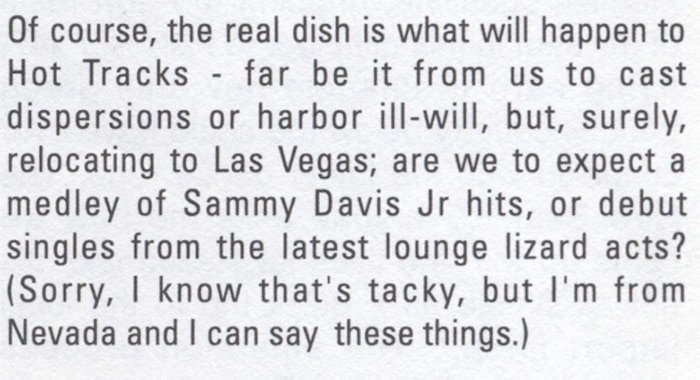
The entry of Razormaid! into the remix service market was initially successful. The professional and carefully conceived packaging also lent the service an air of flash that was appealing to record labels. Early on, Watt got in the habit of always working with the full compliance of the artists he was re-editing, “As [they] received copies of our finished product, they saw our professionalism – that we were concerned with quality. I remember calling Trevor Horn to ask his permission for something and he was completely baffled, ‘What, you’re asking permission? Why? Everyone else just does it and puts them out as bootlegs.’ Working directly with the labels opened a lot of doors for us.”
One such door came early on, when they struck a deal with Virgin Records. Watt and Maharg temporarily relocated to London in 1985, running the service officially from San Francisco, while performing remix work in the UK. “Oh, it was hilarious... Here we were just two boys from San Francisco and we wanted to look professional, so we wore these suits. But this was Virgin, it was like the punk rock label, everyone had leather jackets and colored hair and all that.”
The deal made Watt, along with Maharg, who’d since taken on re-editing duties, one of Virgin’s in-house remixers, with payment to be made in studio time, “It was a pretty good deal, it would have cost me five grand a session. They also let me work at any room I wanted in Europe: Stockholm, Copenhagen, Berlin, Frankfurt, Austria – I got a good look at all the best engineers.” This transformed the Razormaid! sound. Up to that point, Watt and Maharg were doing tape edits. Now they had access to a multi-track recording studio, which allowed them to re-EQ, layer complex overlays, and record new parts. The EQing took on an increasingly more important role, with Watt relying on his trained musical ear to tweak the frequencies so that his mixes hit more aggressively, and more clearly, in clubs.
Many of Razormaid!’s most coveted tracks came from this period. While Watt and Maharg were in London, they also spent time visiting Europe, digging for weird and overlooked tracks that fit their aesthetic. Consequently, the service began to take on a darker, harder edge informed by New Beat and the pre-techno murmurings of Berlin – tracks like DAF’s “The Gun,” DATA’s “Living Inside Me,” and Bigod 20’s “America.” The graphics also became more industrial and abstract, utilizing die-cut holes across the spine and on the front and back of the jacket, which, when holding a sleeve, used Morse code dots to create a system that allowed savvy DJs to know, at a glance, which issue they were looking at.
Back in America, Razormaid! took off in Texas, via major venues like Dallas’ Starck Club, and Chicago, where the edits formed the backbone of popular industrial clubs like Medusa’s and The Limelight, and on WBMX, the city’s dance music radio station.
The Hot Mix 5 would put them in, and you’d think it was like an abstract or different version... and you ask people – DJ’s in the know – and they’d say, “No, that’s Razormaid!”
“Razormaid! has been a part of Chicago music culture since its inception,” says Jamal Moss, the industrial house producer known as Hieroglyphic Being; in the ’00s he created “Medusa Edits,” an industrial and New Wave re-edit series inspired by Watt’s work. “Technically speaking, any real disc jock, or real record player in Chicago, no matter what side of the city they’re from, they’re looking for choice cuts. And Razormaid!’s were some of the choice cuts that people put in their collection to separate themselves. The Hot Mix 5 would put them in, and you’d think it was like an abstract or different version, maybe a Farley edit or Julian ‘Jumpin’ Perez or whoever, and you ask people – DJ’s in the know – and they’d say, ‘no, that’s Razormaid!’” He says that, at the time, all the major shops – Wax Trax!, Imports Inc. , and Gramaphone – carried Razormaid! “You have to remember, Chicago is an industrial city as well as a house city; it was very strong pop culture here. There was a crossover, you had industrial engineers working on house tracks, and house engineers working on industrial tracks. It had its influence on people who later went on to make house music, or beats, or whatever.”
After London, Watt and Maharg returned to the United States, and resumed full operations in San Francisco. This lasted for a while, but they found the climate of the city to be claustrophobic, “We returned to discover the entire scene in San Francisco consisted of Megatone Records and Top 40 pop. Two of our favorites!! Not!” wrote Watt.
In this period, they expanded their reach, but became reclusive, preferring not to go to local clubs at all. They began the Test series, which featured more remixes of less challenging tracks, a consequence of their observations of what was popular stateside. “So artists like Sylvester appeared on Razormaid! alongside Revolting Cocks, etc. (I feel sick just thinking about it).” But they also created the techno-centric Cycle Sector series and Class X series, which focused on remixes of material released prior to the founding of Razormaid! Around this time, in 1986, Watt purchased a computer and switched from tape editing to a computer sound editing program called Sound Designer II, created by Digidesign. Watt became involved with the development of the software, informing its creators of its real-world, dance music applications. He’s mixed digitally since.
Why is it that the lyrical content of dance music must be restricted to “shaking one’s booty” and such?
The service’s issues took on an increasingly bleak character, culminating in the release of its Fourth Anniversary Issue in 1989. Titled The Atrocity Exhibition in honor of the JG Ballard book of the same name, its cover featured blunt imagery of animals used in laboratory experiments. Some subscribers were not so enthused, in a newsletter from the same year, Maharg wrote, “I’d like to defend this ‘morbid’ business. Why is it that the lyrical content of dance music must be restricted to ‘shaking one’s booty’ and such? When we go to the movies, we are entertained and fascinated by violence, sex, and death. But if we go dancing, we are subjected to lyrics so infantile that they are spelling out in some degrading pre-school fashion, i.e. ‘U Do It 2 Me.’”
In truth, the increasingly dark turn was coming from a very real place. Art Maharg had become HIV positive, and was beginning a battle that would claim his life. Razormaid! relocated to Santa Rosa, a city 55 miles north of San Francisco in the Sonoma wine country. The move didn’t change much: Watt and Maharg remained prolific in the following years. They started pressing CDs as well as records, changing the name of Test to Gridlock!, and kept up with the increasingly house and techno-centric developments in Germany and Belgium via their Seismic Sound series. Sadly, Maharg passed away in 1992. “My partnership with my best friend is over, but my memories from my experiences with him will carry me through everyday for the rest of my life. Without Art, I would have thrown in the towel long ago,” wrote Watt.

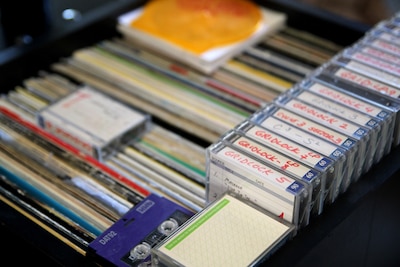

Maharg’s death didn’t affect the growth of Razormaid!, however. Watt continued the service through the ’90s and ’00s, working with major pop acts like Madonna, while exploring the effects of drastic BPM change on the Spacial Anomalies series, and also expanding into the burgeoning fields of trance and Eurobeat, “It’s what keeps me in business. These Europeans always drop out the rhythm as soon as the vocal comes in.” He first moved to Palm Springs, and then later to Scottsdale. While there, he connected with and advised Audiofile Engineering, a software company in Minneapolis dedicated to recreating Watt’s beloved Sound Desginer II program. The application they made, Wave Editor, is something he still uses in his studio today, despite the company’s recent attempts to update it and rebrand it as Triumph.
2014 marks an important year for Razormaid! For the first time in a long while, Watt is working on new edits, and has planned out a whole release schedule of issues that he plans to use to place his touch on contemporary big room dance music. On January 1st, he announced the Razormaid Library, a hard disk available for purchase that contains every remix and re-edit the service has done in its 25 year run. Looking back on the breadth and scope of the service, it’s almost impossible to estimate the size of its impact.

This feature is part of a week of articles guest curated by Levon Vincent.
Says Levon, “Even as a teenager I remember paying 50 bucks to get a copy of a Razormaid record. Joseph Watt had it really dialed in for eight or ten years. I mean, really dialed in. The music was great, but also the conceptual things, the graphic design and the whole mystical appeal of editing on cassette and magnetic tape. I mean, he was spinning that whole thing as a marketable hip concept. ”
To check out more of the features that Levon Vincent picked out, check out his guest curator hub page.

